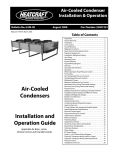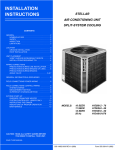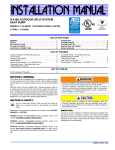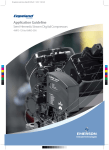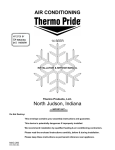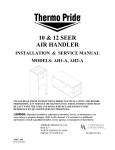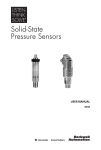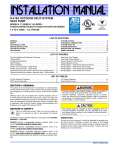Download York MC Installation manual
Transcript
INSTALLATION MANUAL FULL-CASED MULTI-POSITION FOR COOLING/HEAT PUMPS MODELS: MC FULL-CASED UPFLOW/COUNTERFLOW FOR COOLING/HEAT PUMPS MODELS: FC PARTIAL-CASED UPFLOW FOR COOLING/HEAT PUMP MODELS: PC ISO 9001 Certified Quality Management System LIST OF SECTIONS SAFETY . . . . . . . . . . . . . . . . . . . . . . . . . . . . . . . . . . . . . . . . . . . . . . . . 1 GENERAL INFORMATION . . . . . . . . . . . . . . . . . . . . . . . . . . . . . . . . . 2 COIL METERING DEVICES . . . . . . . . . . . . . . . . . . . . . . . . . . . . . . . . 4 COIL INSTALLATION . . . . . . . . . . . . . . . . . . . . . . . . . . . . . . . . . . . . . 4 DUCT CONNECTIONS . . . . . . . . . . . . . . . . . . . . . . . . . . . . . . . . . . . . 6 CONDENSATE DRAIN CONNECTIONS . . . . . . . . . . . . . . . . . . . . . . .6 REFRIGERANT LINE CONNECTION . . . . . . . . . . . . . . . . . . . . . . . . .7 COIL CLEANING . . . . . . . . . . . . . . . . . . . . . . . . . . . . . . . . . . . . . . . . .7 AIR SYSTEM ADJUSTMENT . . . . . . . . . . . . . . . . . . . . . . . . . . . . . . .7 INSTALLATION VERIFICATION . . . . . . . . . . . . . . . . . . . . . . . . . . . . .8 LIST OF FIGURES Component Location - Coil MC & FC . . . . . . . . . . . . . . . . . . . . . . . . . . 2 Component Location - Coil PC . . . . . . . . . . . . . . . . . . . . . . . . . . . . . . . 2 TXV Bulb Installation . . . . . . . . . . . . . . . . . . . . . . . . . . . . . . . . . . . . . . 4 Proper Bulb Location . . . . . . . . . . . . . . . . . . . . . . . . . . . . . . . . . . . . . . 4 Vertical Applications . . . . . . . . . . . . . . . . . . . . . . . . . . . . . . . . . . . . . . . 4 Coil Flange . . . . . . . . . . . . . . . . . . . . . . . . . . . . . . . . . . . . . . . . . . . . . . 5 Horizontal Right Application . . . . . . . . . . . . . . . . . . . . . . . . . . . . . . . . . 5 Horizontal Left Application . . . . . . . . . . . . . . . . . . . . . . . . . . . . . . . . . . 5 Upflow Coil Installation . . . . . . . . . . . . . . . . . . . . . . . . . . . . . . . . . . . . .6 Condensate Deflector on Vertical Drain Pan . . . . . . . . . . . . . . . . . . . .6 Condensate Deflector on Horizontal Drain Pan Edge . . . . . . . . . . . . .7 S-Clip Installation . . . . . . . . . . . . . . . . . . . . . . . . . . . . . . . . . . . . . . . . .7 Pressure Check . . . . . . . . . . . . . . . . . . . . . . . . . . . . . . . . . . . . . . . . . .8 TXV Check List . . . . . . . . . . . . . . . . . . . . . . . . . . . . . . . . . . . . . . . . . . .8 Drain Traps . . . . . . . . . . . . . . . . . . . . . . . . . . . . . . . . . . . . . . . . . . . . . .8 Location of Trapped and Plugged Drain Connections . . . . . . . . . . . . .8 LIST OF TABLES Dimensions - MC Coils . . . . . . . . . . . . . . . . . . . . . . . . . . . . . . . . . . . . . 2 Dimensions - FC Coils . . . . . . . . . . . . . . . . . . . . . . . . . . . . . . . . . . . . . 3 Dimensions - PC Coils . . . . . . . . . . . . . . . . . . . . . . . . . . . . . . . . . . . . . 3 Coil Air Flow Limits . . . . . . . . . . . . . . . . . . . . . . . . . . . . . . . . . . . . . . . . 4 Entering Air Temperature Limits . . . . . . . . . . . . . . . . . . . . . . . . . . . . . .4 Coil Projection Dimensions - PC Coils . . . . . . . . . . . . . . . . . . . . . . . . .6 Air Flow Data - Static Pressure Drop . . . . . . . . . . . . . . . . . . . . . . . . . .7 SECTION I: SAFETY This is a safety alert symbol. When you see this symbol on labels or in manuals, be alert to the potential for personal injury. Understand and pay particular attention to the signal words DANGER, WARNING, or CAUTION. This product must be installed in strict compliance with the enclosed installation instructions and any applicable local, state, and national codes including, but not limited to building, electrical, and mechanical codes. DANGER indicates an imminently hazardous situation, which, if not avoided, will result in death or serious injury. WARNING indicates a potentially hazardous situation, which, if not avoided, could result in death or serious injury. CAUTION indicated a potentially hazardous situation, which, if not avoided may result in minor or moderate injury. It is also used to alert against unsafe practices and hazards involving only property damage. Improper installation may create a condition where the operation of the product could cause personal injury or property damage. Improper installation, adjustment, alteration, service or maintenance can cause injury or property damage. Refer to this manual for assistance or additional information, consult a qualified installer or service agency. The furnace area must not be used as a broom closet or for any other storage purposes, as a fire hazard may be created. Never store items such as the following on, near or in contact with the furnace. 1. Spray or aerosol cans, rags, brooms, dust mops, vacuum cleaners or other cleaning tools. 2. Soap powders, bleaches, waxes or other Cleaning compounds; plastic items or containers; gasoline, kerosene, cigarette lighter fluid, dry cleaning fluids or other volatile fluid. 3. Paint thinners and other painting compounds. 4. Paper bags, boxes or other paper products Never operate the furnace with the blower door removed. To do so could result in serious personal injury and/or equipment damage. 525923-UIM-A-0809 525923-UIM-A-0809 SECTION II: GENERAL INFORMATION This instruction covers the installation of the following coils with 80+ or 90+ AFUE furnaces or MA/MV air moving systems. The coils have sweat connect fittings. All coils are shipped with a low psi nitrogen holding charge. Suction Line Connection Liquid Line Connection Coil Access Panel Coil Access Panel Primary Drain Secondary Drain Suction Line Connection Label Location Bottom Door Panel Alternate Drain Locations Liquid Line Connection Label Location FIGURE 2: Component Location - Coil PC INSPECTION Primary Drain Drain Location Horizontal Application (on MC Coils Only) Alternate Drain Location Secondary Drain Bottom Door Panel FIGURE 1: Component Location - Coil MC & FC As soon as a coil is received, it should be inspected for possible damage during transit. If damage is evident, the extent of the damage should be noted on the carrier’s delivery receipt. A separate request for inspection by the carrier’s agent should be made in writing. See Local Distributor for more information. Check drain pan for cracks or breakage. CLEARANCES DURING INSTALLATION Clearance must be provided for: 1. 2. 3. 4. 5. Refrigerant piping and connections Maintenance and servicing access - including cleaning the coil Condensate drain line Filter removal / change Removal of coil assembly TABLE 1: Dimensions - MC Coils ” 3/8 ng) 20 peni (O C 3/4” Flange B A 22” 20 1/4” D BOTTOM OPENING DIMENSIONS Model A B C D 18A 18B 24A 24B 30A 30B 32A 35B 35C 36A 36B 36C 37A 42B 42C 43B 43C 48C 48D 60D 62D 14.5 17.5 14.5 17.5 14.5 17.5 14.5 17.5 21 14.5 17.5 21 14.5 17.5 21 17.5 21 21 24.5 24.5 24.5 22 22 26.5 26.5 26.5 26.5 22 22 22 26.5 26.5 26.5 26.5 32 32 26.5 26.5 32 32 32 36 13 3/8 16 3/8 13 3/8 16 3/8 13 3/8 16 3/8 13 3/8 16 3/8 19 7/8 13 3/8 16 3/8 19 7/8 13 3/8 16 3/8 19 7/8 16 3/8 19 7/8 19 7/8 23 3/8 23 3/8 23 3/8 13.5 16.5 13.5 16.5 13.5 16.5 13.5 16.5 20 13.5 16.5 20 13.5 16.5 20 16.5 20 20 23.5 23.5 23.5 All MC coils include a factory installed horizontal drain pan. (3X) = Models require field installed metering device. 1. Refrigerant line sizes may require larger lines for extended line lengths. See York bulletin #690.01-AD1V for details. 2 Refrigerant Line Size1 Liquid Vapor 3/8 3/4 3/8 3/4 3/8 3/4 3/8 3/4 3/8 3/4 3/8 3/4 3/8 3/4 3/8 3/4 3/8 3/4 3/8 7/8 3/8 7/8 3/8 7/8 3/8 3/4 3/8 7/8 3/8 7/8 3/8 7/8 3/8 7/8 3/8 7/8 3/8 7/8 3/8 7/8 3/8 7/8 525923-UIM-A-0809 TABLE 2: Dimensions - FC Coils ” 3/8 ng) 20 peni (O C 3/4” Flange B 22” A 20 1/4” D BOTTOM OPENING DIMENSIONS Model A B C D 18A 18B 24A 24B 30A 30B 32A 35B 35C 36A 36B 36C 37A 42B 42C 43B 43C 48C 48D 60C 60D 62D 64D 14.5 17.5 14.5 17.5 14.5 17.5 14.5 17.5 21 14.5 17.5 21 14.5 17.5 21 17.5 21 21 24.5 21 24.5 24.5 24.5 18 18 22 22 22 22 20 20 20 24.5 24.5 24.5 24.5 28 28 24.5 24.5 28 28 28 28 32 36 13 3/8 16 3/8 13 3/8 16 3/8 13 3/8 16 3/8 13 3/8 16 3/8 19 7/8 13 3/8 16 3/8 19 7/8 13 3/8 16 3/8 19 7/8 16 3/8 19 7/8 19 7/8 23 3/8 19 7/8 23 3/8 23 3/8 23 3/8 13.5 16.5 13.5 16.5 13.5 16.5 13.5 16.5 20 13.5 16.5 20 13.5 16.5 20 16.5 20 20 23.5 20 23.5 23.5 23.5 RefrigerantLine Size1 Liquid Vapor 3/8 3/4 3/8 3/4 3/8 3/4 3/8 3/4 3/8 3/4 3/8 3/4 3/8 3/4 3/8 3/4 3/8 3/4 3/8 7/8 3/8 7/8 3/8 7/8 3/8 3/4 3/8 7/8 3/8 7/8 3/8 7/8 3/8 7/8 3/8 7/8 3/8 7/8 3/8 7/8 3/8 7/8 3/8 7/8 3/8 7/8 All FC coils are not available with a factory installed horizontal drain pan. (3X) = Models require field installed metering device. 1. Refrigerant line sizes may require larger lines for extended line lengths. See York bulletin #690.01-AD1V for details. TABLE 3: Dimensions - PC Coils ” 3/8 ng) 20 peni (O C (Opening) B 12” A 22” 20 1/4” D BOTTOM OPENING DIMENSIONS Model A B C D 18A 18B 24A 24B 30A 30B 32A 35B 35C 36A 36B 36C 37A 42B 42C 43B 43C 48C 48D 60C 60D 14.5 17.5 14.5 17.5 14.5 17.5 14.5 17.5 21 14.5 17.5 21 14.5 17.5 21 17.5 21 21 24.5 21 24.5 17 3/4 17 21 7/8 21 3/8 21 7/8 21 3/8 20 18 7/8 18 3/4 23 7/8 23 1/8 22 7/8 23 7/8 27 5/8 27 1/8 23 1/8 22 5/8 25 3/8 24 5/8 27 1/2 26 7/8 13 3/8 16 3/8 13 3/8 16 3/8 13 3/8 16 3/8 13 3/8 16 3/8 19 7/8 13 3/8 16 3/8 19 7/8 13 3/8 16 3/8 19 7/8 16 3/8 19 7/8 19 7/8 23 3/8 19 7/8 23 3/8 13.5 16.5 13.5 16.5 13.5 16.5 13.5 16.5 20 13.5 16.5 20 13.5 16.5 20 16.5 20 20 23.5 20 23.5 Refrigerant Line Size1 Liquid Vapor 3/8 3/4 3/8 3/4 3/8 3/4 3/8 3/4 3/8 3/4 3/8 3/4 3/8 3/4 3/8 3/4 3/8 3/4 3/8 7/8 3/8 7/8 3/8 7/8 3/8 3/4 3/8 7/8 3/8 7/8 3/8 7/8 3/8 7/8 3/8 7/8 3/8 7/8 3/8 7/8 3/8 7/8 All PC coils are not available with a factory installed horizontal drain pan. (3X) = Models require field installed metering device. 1. Refrigerant line sizes may require larger lines for extended line lengths. See York bulletin #690.01-AD1V for details. 3 525923-UIM-A-0809 LIMITATIONS These coils should be installed in accordance with all national and local safety codes. Check Tables 4 and 5 for operating limitations. TABLE 4: Coil Air Flow Limits Coil Size Outdoor Unit Tons 18 1-1/2 1-1/2 2 2 2-1/2 2-1/2 3 2-1/2 3 3 3-1/2 3 3-1/2 3 3-1/2 4 4 5 24 30, 32 35 36, 37 42 43 48 60, 62, 64 CFM Limits Minimum Maximum 525 675 525 675 700 900 700 900 875 1125 875 1125 1050 1200 875 1125 1050 1350 1050 1350 1225 1575 1050 1350 1225 1575 1050 1350 1225 1575 1400 1800 1600 1800 1750 2250 Vapor Line Thermal Expansion Valve Bulb (Wrapped with insulation) Liquid Line Thermal Expansion Valve Distributor Body TXV Equalizer Line FIGURE 3: TXV Bulb Installation SCREW TXV BULB (Cover completely with insulation) NUT CLAMP SUCTION LINE FIGURE 4: Proper Bulb Location TABLE 5: Entering Air Temperature Limits WET BULB TEMP. (°F) MIN. MAX. 57 72 DRY BULB TEMP. (°F) MIN. MAX. 65 95 SECTION III: COIL METERING DEVICES If the model number is of the following format: *****4F***, *****4G***, *****4H***, *****4J***, or *****4K*** - The coil will have an R410A TXV metering device installed at the factory. If the model number is of the following model series: *****3X*** - The coil will require a TXV to be installed in the field. Refer to installation manual with TXV kit. It is recommended to install the TXV kit prior to installation of coil in cabinet and brazing line sets. Models matched with orifices: Alternate *****3X***, consult the outdoor installation guide for outdoor units that require an orifice as a metering device for the indoor coil. The orifice and the Schraeder core are supplied with the outdoor unit. Install Schraeder core in the suction line Schraeder body and cap with the supplied plastic cap. COIL UNDER PRESSURE. Relieve pressure by removing plug from piping connection. Coil may have factory installed TXV or may require TXV to be added. See outdoor unit documentation for correct TXV to be used. Refer to coil nameplate for TXV identification for this unit. NOTE: The coil should be open to the air for no more than 2 minutes to keep moisture and contaminates from entering the system. If the coil cannot be brazed into the refrigeration system in that time, the ends should be temporarily closed or plugged. For a short term delay, use masking tape over the ends of the copper tubing to close the tube to the air. For a longer term delay, use plugs or caps. There is no need to purge the coil if this procedure is followed. SECTION IV: COIL INSTALLATION TXV METERING DEVICE Please refer to Technical Guide to verify which TXV is installed in this coil and that this is a valid system match for the AC or HP unit installed. Furnace The temperature sensing bulb is attached to the coil suction header line. NOTE: For models that have factory installed TXV’s, take caution not to apply high temperatures to the TXV assembly or equalizer line while brazing. Furnace UPFLOW FIGURE 5: Vertical Applications 4 DOWNFLOW 525923-UIM-A-0809 FURNACE ASSEMBLY - MC & FC FURNACE ASSEMBLY - (MC ONLY) These coils are factory shipped for installation in either upflow or downflow applications with no conversion. MC coils are supplied ready to be installed in a horizontal position. A horizontal pan is factory installed. MC coils should be installed in all horizontal applications with the horizontal drain pan side down. 1. 2. Position the coil casing over or under the furnace opening as shown in Figure 8 after configuring coil flanges as required see “Coil Flange” section below and refer to Figure 9. Place the ductwork over the coil casing flange and secure.See sections on "Refrigerant Line Connections" and "Condensate Drain Connections". One mounting plate is provided with the coils. NOTE: When installing this coil with an oil furnace, a minimum of six inches clearance should be maintained from the top of the heat exchanger. COIL FLANGE - FOR DOWNFLOW AND HORIZONTAL LEFT KIT INSTALLATION The coils include removable flanges to allow proper fit up with furnaces or two-piece air handlers having various inlet and outlet flange configurations. The two flanges are attached to the top of the coil in the factory during production. If the installation requires the flanges to be moved to the bottom of the coil, remove the screws attaching the flanges to the top of the coil casing. Next, install the flanges to the bottom of the coil casing using the same screws. Refer to Figure 9. Furnace FIGURE 7: Horizontal Right Application For horizontal left hand applications no conversion is required to an MC coil when used with a downflow/horizontal furnace. A mounting plate, supplied with every coil should always be installed on the side designated as top side. See Figure 10 & 11. The additional holes in the upper area of the flanges may be used to attach the coil to the furnace or two-piece air handler. This is done by installing field-supplied screws through the flanges into the inside of the furnace or two-piece air handler casing. The front flange is also designed so that it can be rotated 180 degrees and re-installed. In this mounting configuration the front flange will extend further to the front of the coil casing to accommodate furnaces or two-piece air handlers that have a greater front-to-back dimension than the coils. Furnace FIGURE 8: Horizontal Left Application FURNACE ASSEMBLY - PC These upflow coils are designed for installation on top of upflow furnaces only. If the coil is used with a furnace of a different size, use a 45° transition to allow proper air distribution through the coil. 1. 2. 3. Position the coil casing over the furnace opening as shown in Figure 12. Place the ductwork over the coil casing flange and secure. Check for air leakage between the furnace and coil casing and seal appropriately. Factory Flange Location Alternate Flange Location Do not drill any holes or drive any screws into the front duct flange on the coil in order to prevent damaging coil tubing (see Figure 12). FIGURE 6: Coil Flange NOTE: When installing this coil with an oil furnace, a minimum of six inches clearance should be maintained from the top of the heat exchanger. NOTE: Refer to the heat pump add-on control instruction before installing an add-on heat pump coil. 5 525923-UIM-A-0809 D and installed in accordance with local and/or national codes. This includes the standards of the National Fire Protection Association for Installation of Air-Conditioning and Ventilating Systems, NFPA No. 90B. C (Min.) Equipment should never be operated without filters. Flexible Duct Collar Field Fabricated Ductwork DO NOT Drill or Screw this Flange Upflow Coil Alternate Drain Location Upflow Furnace All drain lines should be pitched away from unit drain pan and should be no smaller than the coil drain connection. Route the drain line so that it doesn’t interfere with accessibility to the coil, furnace, air handling system or filter and will not be exposed to freezing temperatures. Instruct the owner that the evaporator coil drain pan should be inspected and cleaned regularly to prevent odors and assure proper drainage. Primary Drain Secondary Drain FIGURE 9: Upflow Coil Installation TABLE 6: Coil Projection Dimensions - PC Coils COIL SIZE PC18 PC24 PC30, PC32, PC35 PC42, PC43, PC36, PC37 PC48 PC60 SECTION VI: CONDENSATE DRAIN CONNECTIONS DIMENSION “C” INCH 3-1/2 4-1/2 4-1/2 5-1/2 6-1/2 9 NOTE: When the coil is installed in an attic or above a finished ceiling, an auxiliary drain pan must be provided under the coil as is specified by most local building codes. Coils should be installed level or pitched slightly toward the drain end. Suggested pitch should not exceed 1/4-inch per foot of coil. If the coil is provided with a secondary drain it should be piped to a location that will give the occupant a visual warning that the primary drain is clogged. If the secondary drain is not used it must be capped. Avoid Double Trapping. NOTE: Dimension “C” should be at least 2/3 of dimension “D”. See Figure 12. CRITICAL COIL PROJECTION The coil assembly must be located in the duct such that a minimum distance is maintained between the top of the coil and the top of the duct. Refer to Table 6. SECTION V: DUCT CONNECTIONS Air supply and return may be handled in one of several ways best suited to the installation. Upflow, horizontal or downflow applications may be used. The vast majority of problems encountered with combination heating and cooling systems can be linked to improperly designed or installed duct systems. It is therefore highly important to the success of an installation that the duct system be properly designed and installed. Use flexible duct collars to minimize the transmission of vibration/noise into the conditioned space. Threaded drain connections should be hand tightened, plus no more than 1 turn. DO NOT use TeflonTM tape, “pipe dope”, or other sealants. The use of a sealant may cause damage and premature failure of the drain pan. NOTE: If the coil is installed in a draw-thru application (modular air handler), it is recommended to trap the primary and secondary drain line. If the secondary drain line is not used, it must be capped. SUCTION FEEDER TUBECONDENSATE DEFLECTOR Upflow or Downflow No action required. See Figure 13. Use 1/2" screws to connect ductwork to unit. If pilot holes are drilled, drill only through field duct and unit flange. Where return air duct is short, or where sound may to be a problem, sound absorbing glass fiber should be used inside the duct. Insulation of duct work is a must where it runs through an unheated space during the heating season or through an uncooled space during the cooling season. The use of a vapor barrier is recommended to prevent absorption of moisture from the surrounding air into the insulation. The supply air duct should be properly sized by use of a transition to match unit opening. All ducts should be suspended using flexible hangers and never fastened directly to the structure. Duct work should be fabricated 6 Condensate Deflector S-Clips (3) Vertical Drain Pan FIGURE 10: Condensate Deflector on Vertical Drain Pan 525923-UIM-A-0809 Horizontal Left or Right 2. Use an appropriate tool to pry out water deflector with two or three sclips from the vertical drain pan. See Figure 13. Relocate the deflector with s-clips on the Horizontal Drain Pan lined up to the coil support bracket. See Figure 14. This positions the deflector below the feeder tubes to channel the condensate to the drain pan. NOTE: The condensate deflector should be installed in the s-clip section which is inside the drain pan edge. See Figure 15. Feeder Tubes S-Clips on Horizontal Pan Condensate Deflector FIGURE 11: Condensate Deflector on Horizontal Drain Pan Edge Condensate Deflector Remove the heat shield from the Customer Packet, soak in water, and install over coil tubing to prevent overheating of cabinet. 3. Wrap a water soaked rag around the coil connection tubes inside the cabinet to avoid damaging the TXV bulb. 4. Remove grommets where tubes exit the cabinet to prevent burning them during brazing. 5. Purge refrigerant lines with dry nitrogen. 6. Braze the suction and liquid lines. 7. Remove the heat shield. 8. Re-attach the grommets to the lines carefully to prevent air leakage. 9. Attach the coil access panel to the cabinet. Refer to Outdoor unit Installation Manual for evacuation, leak check and charging instructions. Lines should be sound isolated by using appropriate hangers or strapping. All evaporator coil connections are copper-to-copper and should be brazed with a phosphorous-copper alloy material such as Silfos-5 or equivalent. DO NOT use soft solder. SECTION VIII: COIL CLEANING If the coil needs to be cleaned, it should be washed with Calgon CalClean (mix one part CalClean to seven parts water). Allow solution to remain on coil for 30 minutes before rinsing with clean water. Solution should not be permitted to come in contact with painted surfaces. SECTION IX: AIR SYSTEM ADJUSTMENT Drain Pan Wall S-Clip FIGURE 12: S-Clip Installation SECTION VII: REFRIGERANT LINE CONNECTION To check the CFM, measure the static pressure drop across the coil using a portable manometer and static pressure tips. To prepare coil for static pressure drop measurements - the system should have been recently operational in cooling mode. NOTE: Table 7 below has WET coil data. Run system for approximately 15 minutes in cooling mode prior to taking measurements. Drill 2 holes, one 3" after the coil (before any elbows in the ductwork) and one 3” before the coil. Insert the pressure tips and read the pressure drop from the manometer. See Table 5 to determine the air flow, and make the necessary adjustments to keep the CFM within the air flow limitations of the coil. TABLE 7: Air Flow Data - Static Pressure Drop Coil Size Coil is under inert gas pressure. Relieve pressure from coil by removing rubber plug. Dry nitrogen should always be supplied through the tubing while it is being brazed, because the temperature required is high enough to cause oxidation of the copper unless an inert atmosphere is provided. The flow of dry nitrogen should continue until the joint has cooled. Always use a pressure regulator and safety valve to insure that only low pressure dry nitrogen is introduced into the tubing. Only a small flow is necessary to displace air and prevent oxidation. Connect lines as follows: NOTE: Route the refrigerant lines to the coil in a manner that will not obstruct service access to the coil, air handling system, furnace flue or filter. 1. Suction and liquid line connections are made outside the cabinet. Leave the tubing connection panel attached to the cabinet with the tubes protruding through it. Coil access panel should be removed for brazing. The lines are expanded to receive the field line set tubes. 18A 18B 24A 24B 30A 30B 32A 35B 35C 36A 37A 36B 36C 42B 42C 43C 48C 48D 60D 62D 64D 0.10 400 425 400 425 425 450 555 600 792 625 689 825 975 825 1025 785 900 1008 1160 1240 1152 CFM @ Static Pressure Drop - IWG (Based on wet coil) 0.15 0.20 0.25 550 710 880 620 830 970 600 800 950 725 900 1075 600 800 950 725 900 1075 725 865 970 800 950 1090 1007 1206 1382 775 925 1025 880 1031 1180 976 1174 1300 1225 1375 1575 1000 1175 1325 1275 1475 1650 1025 1210 1400 1075 1300 1475 1224 1451 1620 1432 1598 1750 1532 1709 1870 1362 1573 1783 0.30 1000 1125 1075 1215 1075 1215 1080 1220 1572 1125 1300 1450 1775 1450 1850 1570 1600 1788 1870 2000 1994 7 SECTION X: INSTALLATION VERIFICATION Was the coil still under pressure when received? Was the coil still under pressure when received? Depress schrader core to check for pressure one time. Pull rubber plug to check for pressure one time. FIGURE 13: Pressure Check Is coil metering device installed correctly? Were the primary and secondary drains trapped correctly? Was the correct TXV installed per the outdoor unit instructions? Is the TXV Bulb positioned correctly? Is Bulb Insulated? Is Equalizer Line connected? Secondary 3” Min. FIGURE 14: TXV Check List Primary FIGURE 15: Drain Traps Were all drains trapped or plugged? Upflow Drain Connections Downflow Drain Connections Right Hand Discharge Furnace Furnace Primary Drain Trapped Furnace Alternate Drain Furnace Left Hand Discharge Primary Drain Trapped Alternate Drain Trap Appropriate Side (All other drain connections should be plugged) Horizontal Drain Conditions (All other drain connections should be plugged) FIGURE 16: Location of Trapped and Plugged Drain Connections Subject to change without notice. Published in U.S.A. Copyright © 2009 by Johnson Controls, Inc. All rights reserved. Johnson Controls Unitary Products 5005 York Drive Norman, OK 73069 525923-UIM-A-0809 Supersedes: 401344-UIM-B-0309










